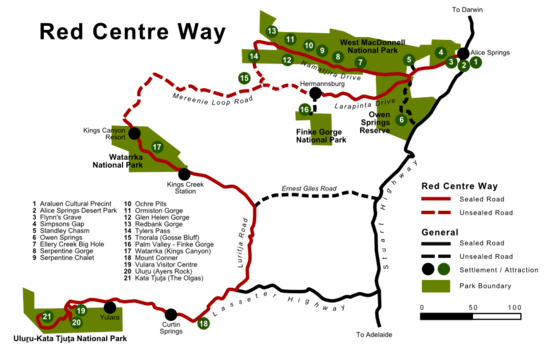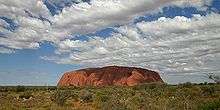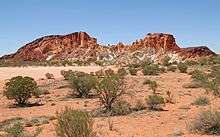Red Centre Itinerary
Understand

The Red Centre is the place where you will find the most famous monolith of Australia, Uluru and it is where the heart of the outback beats. The only town of sizable population is Alice Springs, the remainder of the population being scattered in smaller communities. The oxidized iron in the soil gives the whole area its distinctive and immediately recognizable reddish glow.
Prepare
Get in
By plane
There is an airport in Alice Springs. Qantas has connecting flights to Darwin, Sydney, Melbourne, Brisbane, Adelaide, Cairns and Perth. There is a flying shuttle to Uluru but Uluru has an airport (Yulara) too, so if you're just flying in to see the rock, you don't have to stop off at Alice. (Although you should!) Tigerair Australia is by far the cheapest way to get to Alice Springs.
By train
The Ghan, like the Orient Express, is a legendary long train ride over a large land area. In 2004, it was extended right through to Darwin. Don't expect complete luxury on the Ghan, however. The rolling stock is rather dated, and while adequate, it was purchased used, and has not been highly refurbished. The scenery is nice though. Expect to pay a premium over the airfare.
By car
Alice Springs is 17 hours drive from Darwin, and 18 hours drive from Adelaide. The Stuart Highway from Adelaide is well-maintained and goes right through Coober Pedy, an underground town famous also for being the opal capital of the world (and worth stopping off for a visit on the way). It continues through Tennant Creek and Katherine all the way up to Darwin. Most backpackers and travellers rent either a car or a campervan, given that insurance is included and you'll most likely get a reliable vehicle. Before renting, consider comparing campervan rentals and ensure you get the best deal possible.
It is worthwhile reading the safety tips for Driving in Australia and always carrying water and ensuring you know the location and opening hours of your fuel and food stops.
Read the rental car conditions carefully. Rental cars in Alice Springs do not offer unlimited free kilometres, however the government tourist office, Territory Discoveries can offer them. Rental cars hired outside of the Northern Territory may not be able to be driven into it. Driving after dark outside of the city limits is generally prohibited.
By bus
Greyhound ply the route to Alice Springs from the north and the south.
Go
Day one
Make your way into Alice Springs. There are no international flights landing the Alice, so you will have to change planes at any of the big Australian cities (Sydney, Melbourne, Cairns, Adelaide, Perth or Darwin). Being in the middle of Australia, it takes more or less two hours to get to Alice Springs from any of the aforementionned cities.
In Alice Springs, walk to the top of the Anzac Hill to get a good view of the town, and pay a visit to the Royal Flying Doctor Service or the School of the Air. They will give you an idea of the vastness of the surrounding areas and how the locals cope with it.
In the evening, take a bite at a restaurant on the Todd Mall.
Day two
.jpg)
In the morning, pick up your 4WD (you will of course have made your reservation beforehand on the internet at Thrifty, Britz or any of the companies offering 4WD rental). Buy your supplies for the coming days (including a lot of fluids).
Head West on the Larapinta Drive, and make your first stop only a few km outside Alice at the very interestingAlice Springs Desert Park, where you will learn a lot about the flora and fauna of the Australian Desert. Allow at least two hours for the visit.
Continue West, enter the West McDonnell National Park. The mountain range is dotted with gaps, waterholes and gorges, (Simpsons Gap, Ormiston Gorge, Stanley Chasm...), making for refreshing short walks. If you have your bathing suit, you can even swim in some of the waterholes (for instance the permanent Ellery Creek Big hole). The water can be very cold compared to the outside air. Make a stop at the Ochre Pits, used by aboriginals to get ceremonial ochre.
Make a stop for the night at Glen Helen Resort, a very casual but clean little place in magnificent surroundings, and actually the only option for a roofed accommodation around.
Day three

The real outback driving begins here. Wake early, walk to the Glen Helen Gorge, and take back your 4WD to continue on the Larapinta Drive, which becomes unsealed. Make a stop at the Redbank Gorge, and walk the 1-hour return trail (without forgetting to take water with you).
Continue on the Mereenie Loop Road, an unsealed dirt road crossing Aboriginal lands, with nice desert scenery around you. Try to take your lunch at the viewpoint of Tyler's Pass, from where there is a truly breathtaking view over the area. You should also be able to see the eroded crater of Tnorala, a truly gigantic comet impact dating from the Cretacean period.
Descend from Tyler's pass, and take a short walk inside Tnorala. The sheer size of what remains after million years of erosion puts the imagination at test about the energy of the original impact.
You should be able to reach Watarrka National Park before sunset, and even have enough time to take the short walk at the bottom of King's Canyon and admire the sunset on the canyon. Take a good night of sleep at the King's Canyon Resort.
Day four

Leave just before sunrise (at least during the hotter months), and head for the Canyon, walk the Rim Walk while it is still not too hot, with plenty of water with you. Admire and absorb the magic of the scenery around you.
After the walk, head for Uluru. Slowly, you will notice that the soil gets sandier and sandier, and soon the (fortunately sealed) road will lead you through dunes. A hundred kilometers before Uluru, you will see Mount Conner in the distance, an anvil shaped mount with a flat top. From the dune on the other side of the viewpoint for Mount Conner, you will also see vast salt lakes spotting the plains. These are all on private property, so admire from afar.
Curtin Springs is the next attraction you will come to. They say home is where the heart is, even if it is spread over a million acres of remote Central Australia! Curtin Springs balances beef production with a million acre wildlife corridor, and offers many ways for visitors to connect with the spectacular landscape. Curtin Springs (the first Wayside Inn in Central Australia), 100 km east of Ayers Rock, offers a base from which to visit the Ayers Rock and Kings Canyon areas. It offers experiences, tours and hospitality. Curtin Springs Wayside Inn: 27 accommodation rooms, campground, store, bar, meals. Curtin Springs Paper - handmade paper from native grasses. 1-hour tours operate daily at 10:30AM or 4PM. Curtin Springs Walks - private guided walks around the salt lakes on Curtin Springs or the base of Mt Conner.
Day five
After some more driving, you will see both Uluru and Kata Tjuta rising in the distance. No matter how many times you have seen the Rock in photographs or videos, the first time you see it rising from the plains truly leaves a strong impression. Get in the park (there is a fee), visit the tourist center, eventually take one of the short walks around the rock, but be at the designated parking spot for the sunset. At the last moment before the sun goes down, it reflects in the rock. The rock then "shines" for a few seconds, producing a truly mesmerizing effect. Head back to one of the accommodation at neighbouring Yulara.

Drive to Kata Tjuta (45 km from the entrance of the park), make a brief stop at the view point and walk the Valley of the Winds, a 7-km loop between the red domes of Kata Tjuta. The trail is not too difficult, but it is sometimes closed in the summer days to the excessive heat (whether the walk in closed or open is indicated at the entrance of the park, so you do not have to drive the 90 km return just to check). If it is too hot or you do not feel like walking 7 km, there is a shorter treck (2 km return).
After Kata Tjuta, head back to Uluru and Yulara. You can make a brief stop at the bottom of the climb to the top of the rock, the climb will be closed in 2019, so there is limited time left to do this bucket list climb.
Anyway, return at Yulara, and take the Sounds of Silence dinner experience. It is quite popular and you will probably have to make a reservation in the morning.
Day six

Wake early, try to be at the sunrise viewing point at Uluru for a reverse effect of the sunset glow. Return to Uluru, and Walk around the base of Uluru. It will take two to three hours, there are many stops with explanations about the aboriginal mythology linked with the rock, as well as rock paintings. Some features are sacred, respect the place and do not take pictures.
Take your vehicle, time to hit back the road. Head back towards the Stuart Highway on the Lesseter highway, take the turn on the Luritja road, but take the unsealed and rough Ernest Giles Road. The track will take you into some barren scenery. Just before reaching the Stuart Highway, turn left to enter the tiny Henbury Meteorites Conservation Reserve. The short loop trail into the reserve will bring you close to very visible craters left by pieces of a meteorites that disintegrated over the desert. One of the craters was deep enough to create some shadow and a temporary waterhole, so the bottom is a bit greenish compared to the incredibly flat and barren surroundings.
Drive back to the Stuart Highway, head back towards Alice Springs, but turn right to get to the Rainbow Valley before sunset (it is a 4-wheel drive with sandy spots from the Stuart highway to the reserve). The colors of the sandstone and rock formations are simply splendid. If you are lucky enough to get there just after the rain, you might get the chance to view the reflection of the rocks over the water.
For the night, head back to Alice, or stay at Jim's place, 90 km south of Alice, a rustic roadhouse with a local attraction, Dinky the Dingo, a dog able to play the piano.
Day seven
From Alice Springs, take the dirt road towards Finke (the entrance of the road is close to the Airport) and head towards Chambers Pillar Historical Reserve | Chambers pillar. Make your first stop at the Ewaninga Conservation Reserve, a small reserve only 30 km from Alice Springs (the entrance of the park is easy to miss). You will see some aboriginal carvings dating from the prehistoric times, that are still sacred.
Hit the track back. You can make a brief stop at the Maryvale Station, an outback fuel station with some refreshment available. Depending on how confident you feel with your driving skills over sand, you might want to tell them you are heading to Chamber's pillar.
The drive from Maryvale to Chamber's pillar starts gently, but slowly becomes a hell of a 4WD track over rougher and rougher terrain. You will then have to drive over a rocky hill, which is really steep. No conventional vehicle can cope with this climb, and even with the 4WD you will have to be in very low gear. On top of the hill, you can have a view of the pillar rising above the desert.
After descending the other side of the hill (which is as steep as the climb, by the way), you will drive the last few kilometers over sand dunes. Take care at the top of each dune, as frontal accidents may happen.
The pillar was used as a landmark for pioneers, and bears some century old graffiti. There are furthermore fantastic views of the desert.
Head back to Alice for the evening, and eat your belly out at the Todd Mall.
Day eight
Last day in Alice. Take your time to pay a visit to the Old telegraph station and buy the necessary souvenirs for the family, but most of all look back at your week and wonder how early explorers did what you did without a 4WD (do not forget to wash it, and return it). Take a shuttle bus to the airport to take your flight.
Stay safe
This is a desertic area, so always bring a lot of water with you if you go out hiking, and in any case bring a lot of water with you while you are driving. It can get dramatically hot in the summer, and even during other seasons, when it is only very hot during the day you should be wary of dehydration. Always wear a hat, and put on strong sunscreen.
Some unsealed roads are fairly remote, so take extra care, as mechanical problems can mean big trouble if you are not prepared. The distance between fuel supplies is not to be underestimated. Check the autonomy of your vehicle, and refuel accordingly.
Remember that most of the land you are driving through is private property. Unless it is specifically marked as national park, it is someones home and their business. Please don't drive off the designated roads, do not camp outside of designated camps, do not cut down trees or other vegetation. There is plenty of deadwood on the ground. Your fire must be totally extinguished before you leave - fires in Central Australia are devastating and it could be another 7 years before it rains again.
Please remember to take all your rubbish with you, including any used toilet paper. Other visitors do not need to see this as part of their holiday!
Remember your rubbish could have a disastrous impact on the biosecurity of the pastoral stations and businesses you have the privilege of driving through.
For more information, carefully read Driving in Australia#Outback driving.
They are not directly life-threatening, but flies can become annoying when they buzz around you by the dozens. You may want to buy a fly-net for your head.
Go next
Having just spent a few days driving around the Red Centre, you probably won't want to drive anywhere. However, if you do want to take your car out, the Stuart Highway runs from Darwin to Port Augusta via Alice Springs.
Alice Springs also has an airport, with flights to Darwin, Sydney, Melbourne, Brisbane, Adelaide, Cairns and Perth.
You could also catch The Ghan north up to Darwin, or south to Adelaide.